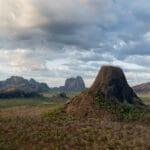Unveiling the Naked Giant: An Introduction
Nanga Parbat, towering at 8,126 meters in the Gilgit-Baltistan region of Pakistan, is the ninth highest mountain in the world. Its breathtaking beauty contrasts sharply with its infamous nickname, “Killer Mountain,” a testament to its perilous climbing history. From triumphs to tragedies, Nanga Parbat’s story is one of human ambition and the enduring allure of the unknown. This article explores the multifaceted nature of this majestic peak, from its geological formation and climbing routes to its cultural significance and the importance of responsible tourism.
Where Giants Sleep: Geography and Geology
Anchoring the western end of the Himalayas, Nanga Parbat stands south of the Indus River in the Diamer District (35.23833°N / 74.58867°E). While summiting this giant is an extreme feat, reaching base camp is surprisingly accessible compared to other 8,000-meter peaks, achievable via a roughly two-day trek from Gilgit. The mountain’s most striking feature is arguably the Rupal Face, possibly the tallest cliff on earth, boasting a staggering 4,600-meter vertical rise. This dramatic geological formation is a testament to the powerful forces that shaped the Himalayas.
Pathways to the Summit: Climbing Routes and Risks
Nanga Parbat offers climbers a variety of challenging routes, each demanding respect and meticulous planning. The Rupal and Diamir Faces are among the most famous, though neither offers an easy ascent. The mountain’s treacherous terrain, unpredictable weather, and sheer altitude contribute to its “Killer Mountain” reputation. Avalanches, sudden storms, and the extreme conditions at high altitude pose significant risks, making Nanga Parbat a formidable challenge even for the most experienced mountaineers.
A Gentler Approach: Trekking and Exploration
For those who prefer a less strenuous experience, Nanga Parbat offers breathtaking trekking opportunities. Fairy Meadows, a picturesque alpine plateau, provides stunning views of the peak and surrounding landscape. Discover the breathtaking beauty and misty allure of Mount Waiʻaleʻale, another destination offering stunning natural vistas. Trekking around Nanga Parbat allows visitors to connect with the mountain’s majesty without the extreme risks associated with climbing, offering a serene alternative for nature enthusiasts and photographers. Exploring the region also offers a chance to discover the unique flora and fauna that thrive in this high-altitude environment, from snow leopards and brown bears to diverse alpine plant life. However, the potential impact of climate change on this fragile ecosystem is a growing concern, with ongoing research suggesting alterations in snow patterns, glacial melt, and local weather conditions.
More Than a Mountain: Culture, History, and Preservation
Locally known as “Diamer,” meaning “King of Mountains,” Nanga Parbat holds deep cultural significance for the surrounding communities. Local folklore is rich with stories and legends about the mountain, passed down through generations. The mountain’s recorded history is filled with tales of daring expeditions, both triumphant and tragic. This rich tapestry of human interaction with the mountain adds another layer to its allure. Explore the vast, shimmering expanse of Niassa Lake to witness another example of the interplay between nature and human culture. As tourism grows, responsible travel practices are vital for preserving Nanga Parbat’s pristine environment. Adhering to “Leave No Trace” principles and respecting local customs ensures that future generations can experience the mountain’s wonder.
Is Nanga Parbat in India or Pakistan?
The majestic Nanga Parbat is definitively located in Pakistan, specifically within the Diamer District of the Gilgit-Baltistan region. This region is under Pakistani administration, adding a layer of complexity given the historical and political sensitivities surrounding the broader Kashmir region. Nanga Parbat stands as the western anchor of the Himalayas, separated from the Karakoram Range by the Indus River. Its local name, “Diamir” or “King of Mountains,” reflects its imposing presence. The Sanskrit name, “Nanga Parbat” (Naked Mountain), likely describes the south face, often bare of snow and ice. The mountain’s location in the disputed territory of Kashmir adds another dimension to its story, highlighting the geopolitical context of the region.
Why is Nanga Parbat Called the Killer Mountain?
Nanga Parbat’s nickname, “Killer Mountain,” is a stark reflection of its dangerous climbing history and high fatality rate. Factors contributing to its perilous nature include unstable glaciers, frequent avalanches, sudden storms, the extreme altitude of 8,126 meters, and the sheer verticality of the Rupal Face. While the exact fatality rate is difficult to determine and may vary over time, it remains significantly higher than other peaks, underscoring the inherent risks. The mountain’s challenges demand the utmost respect, meticulous planning, and a deep understanding of mountaineering from those who dare to attempt its ascent.
Which Pakistani Climbers Ascended Nanga Parbat?
In a historic achievement, Naila Kiani and Samina Baig became the first Pakistani women to summit Nanga Parbat on July 2, 2023. Their triumph is a testament to human resilience, challenging the mountain’s “Killer Mountain” reputation. This milestone highlights the growing prominence of Pakistani women in mountaineering, inspiring future generations and signifying the indomitable human spirit. Their success also underscores the importance of evolving climbing techniques, technological advancements, and a heightened awareness of safety protocols in tackling such a formidable peak. While their achievement stands as a testament to human endeavor, it also emphasizes the ongoing dialogue surrounding the ethical considerations and responsible climbing practices associated with such a dangerous mountain.
- Crypto Quotes’ Red Flags: Avoid Costly Mistakes - June 30, 2025
- Unlock Inspirational Crypto Quotes: Future Predictions - June 30, 2025
- Famous Bitcoin Quotes: A Deep Dive into Crypto’s History - June 30, 2025
















